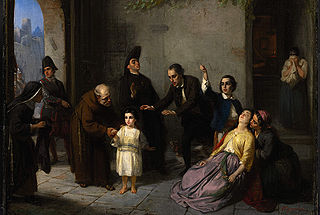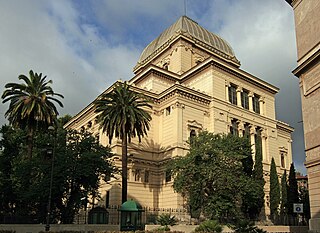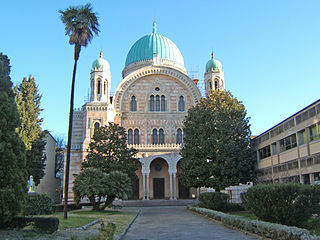Related Research Articles

Ancona is a city and a seaport in the Marche region in central Italy, with a population of around 101,997 as of 2015. Ancona is the capital of the province of Ancona and of the region. The city is located 280 km (170 mi) northeast of Rome, on the Adriatic Sea, between the slopes of the two extremities of the promontory of Monte Conero, Monte Astagno and Monte Guasco.

The Mortara case was an Italian cause célèbre that captured the attention of much of Europe and North America in the 1850s and 1860s. It concerned the Papal States' seizure of a six-year-old boy named Edgardo Mortara from his Jewish family in Bologna, on the basis of a former servant's testimony that she had administered an emergency baptism to the boy when he fell ill as an infant. Mortara grew up as a Catholic under the protection of Pope Pius IX, who refused his parents' desperate pleas for his return. Mortara eventually became a priest. The domestic and international outrage against the Pontifical State's actions contributed to its downfall amid the unification of Italy.

The Roman Ghetto or Ghetto of Rome was a Jewish ghetto established in 1555 in the Rione Sant'Angelo, in Rome, Italy, in the area surrounded by present-day Via del Portico d'Ottavia, Lungotevere dei Cenci, Via del Progresso and Via di Santa Maria del Pianto, close to the River Tiber and the Theatre of Marcellus. With the exception of brief periods under Napoleon from 1808 to 1815 and under the Roman Republics of 1798–99 and 1849, the ghetto of Rome was controlled by the papacy until the capture of Rome in 1870.

The history of the Jews in Italy spans more than two thousand years to the present. The Jewish presence in Italy dates to the pre-Christian Roman period and has continued, despite periods of extreme persecution and expulsions, until the present. As of 2019, the estimated core Jewish population in Italy numbers around 45,000.

David Israel Kertzer is an American anthropologist, historian, and academic, specializing in the political, demographic, and religious history of Italy. He is the Paul Dupee, Jr. University Professor of Social Science, Professor of Anthropology, and Professor of Italian Studies at Brown University. His book The Pope and Mussolini: The Secret History of Pius XI and the Rise of Fascism in Europe (2014) won the 2015 Pulitzer Prize for Biography or Autobiography. From July 1, 2006, to June 30, 2011, Kertzer served as Provost at Brown.

Sant'Angelo is the 11th rione of Rome, Italy, located in Municipio I. Often written as rione XI - Sant'Angelo, it has a coat of arms with an angel on a red background, holding a palm branch in its left hand. In another version, the angel holds a sword in its right hand and a scale in its left.

The history of the Jewish community of Venice, which is the capital of the Veneto region of Italy has been well known since the medieval era.
This timeline of antisemitism chronicles events in the history of antisemitism, hostile actions or discrimination against Jews as members of a religious and/or ethnic group. It includes events in Jewish history and the history of antisemitic thought, actions which were undertaken in order to counter antisemitism or alleviate its effects, and events that affected the prevalence of antisemitism in later years. The history of antisemitism can be traced from ancient times to the present day.

In the early modern era, European Jews were confined to ghettos and placed under strict regulations as well as restrictions in many European cities. The character of ghettos fluctuated over the centuries. In some cases, they comprised a Jewish quarter, the area of a city traditionally inhabited by Jews. In many instances, ghettos were places of terrible poverty and during periods of population growth, ghettos had narrow streets and small, crowded houses. Residents had their own justice system. Around the ghetto stood walls that, during pogroms, were closed from inside to protect the community, but from the outside during Christmas, Pesach, and Easter Week to prevent the Jews from leaving at those times.
The relations between Pope Pius IX and Judaism were off to a good start at the beginning of his papacy, but relations later soured after anti-clerical revolutions removed most of the pontiff's temporal power, and he stiffened into intolerance. While Pius rejected charges of antisemitism, the rift created by the Mortara Affair, undermined his moral authority in the eyes of some during the rest of his pontificate.

The history of the Jews in Florence can be traced over nine hundred years. Florence is the capital city of the Italian region of Tuscany and of the province of Florence. The Jews of Florence have one of the oldest continuous Jewish communities in Europe. The historic Jewish community in Florence is one of the largest and one of the most influential Jewish communities in Italy. The Jewish community in Florence also serves the smaller neighboring Jewish communities in Pisa, Livorno, and Siena.
The history of the Jews in Ancona in Italy, began when Jews settled into the city in the first half of the 14th century, contributing to money-lending and other economic roles.

The raid on the Roman Ghetto took place on 16 October 1943. A total of 1,259 people, mainly members of the Jewish community—numbering 363 men, 689 women, and 207 children—were detained by the Gestapo. Of these detainees, 1,023 were identified as Jews and deported to the Auschwitz concentration camp. Of these deportees, only fifteen men and one woman survived.

The Jewish Museum of Rome is situated in the basement of the Great Synagogue of Rome and offers both information on the Jewish presence in Rome since the second century BCE and a large collection of works of art produced by the Jewish community. A visit to the museum includes a guided tour of the Great Synagogue and of the smaller Spanish Synagogue in the same complex.
Impade is a cookie of Sephardi Jewish origin that is most commonly found among members of the Venetian Jewish community and their descendants, and is traditionally prepared at Purim, but is also prepared year round.

The Jewish Museum of Florence is a museum of Jewish history located in the Great Synagogue of Florence, Italy. The museum, which covers two spaces of the building, gathers an important collection of ancient objects of Jewish ceremonial art, evidence of the high artistic level achieved by the Jewish-Italian communities in the field of applied arts. Exhibitions illustrate the history of Florentine Jews from the first settlements to the post-war reconstruction, featuring old photographs, films and a large number of objects of daily and commemorative use.

The Jewish Museum of Venice is a museum focusing on the history of Jews in the city of Venice.

Kidnapped is a 2023 Italian-language historical drama film co-written and directed by Marco Bellocchio, about Edgardo Mortara, a young Jewish boy who was taken from his family by the Papal States and raised as a Catholic. It is loosely based on Daniele Scalise's book Il caso Mortara. It is a co-production between Italy, France and Germany.
References
- ↑ Museo Ebraico of Bologna.
- ↑ Bologna Welcome, website.
- ↑ Gardens and Ghettos: The Art of Jewish Life in Italy, by Vivian B. Mann, Jewish Museum (New York, N.Y.), page 251.
- ↑ The Kidnapping of Edgardo Mortara, by David I. Kertzer.
- ↑ Jewish Virtual Library, entry on Bologna.